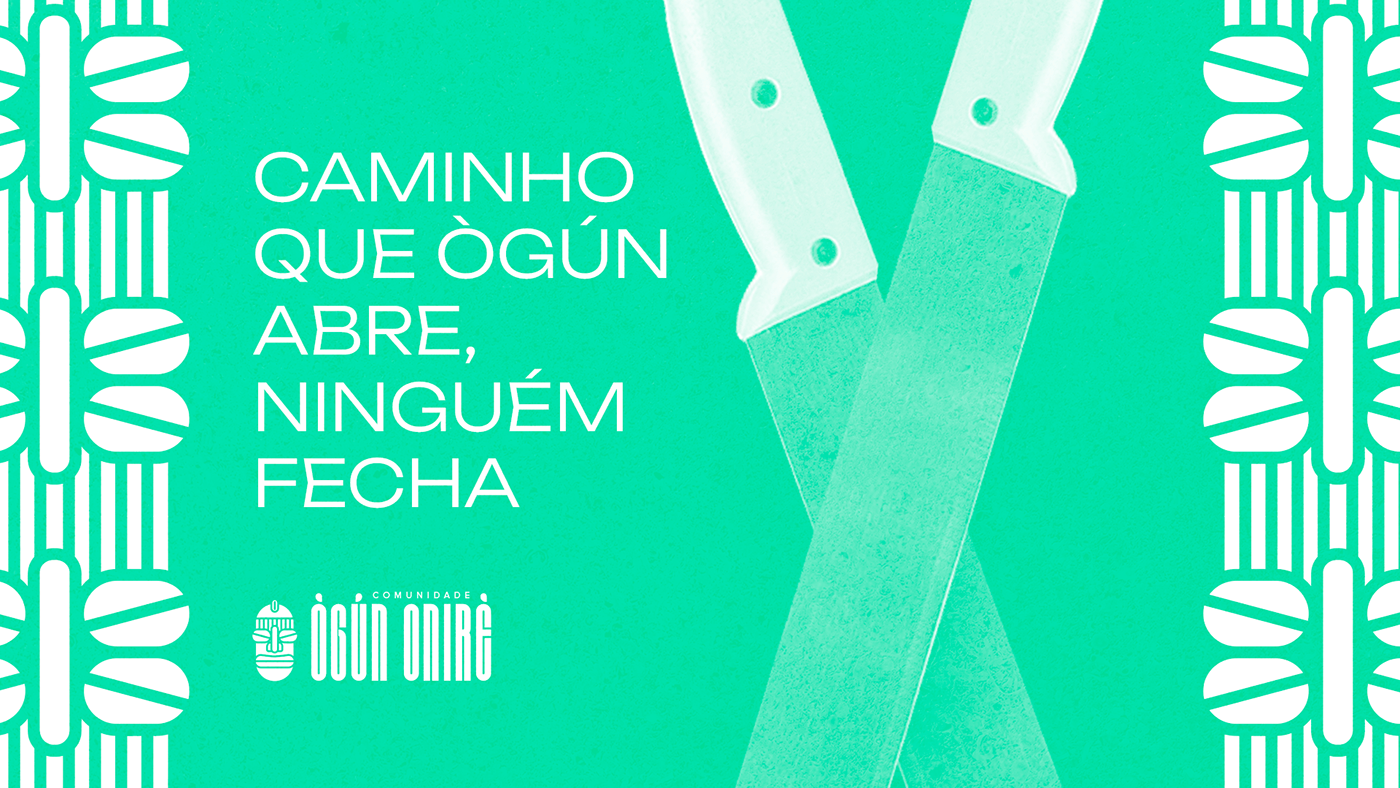
Identidade Visual - São Paulo/SP - 2023
[PT-BR]
Regido pelo Pai de Santo e Sacerdote Lucas Maganhato e pela Mãe de Santo e Sacerdotiza
Fiama Miranda com o objetivo de resgatar valores trazidos de seus ancestrais para dentro
da comunidade, acreditando que a cultura de terreiro caminha lado a lado na composição
da sociedade brasileira pensando em inclusão por meio de lutas sociopolíticas mais justas.
Fiama Miranda com o objetivo de resgatar valores trazidos de seus ancestrais para dentro
da comunidade, acreditando que a cultura de terreiro caminha lado a lado na composição
da sociedade brasileira pensando em inclusão por meio de lutas sociopolíticas mais justas.
O projeto é uma nova proposta de identidade visual para a comunidade Ògún Onirè,um terreiro de Umbanda que teve seu nome alterado, sendo anteriormente conhecido como Terreiro de Umbanda Ogum Sete Espadas. Sendo assim, o desafio foi repensar aspectos da marca que conversasse com tais mudanças que pudesse traduzir da melhor forma possível a representação da comunidade, tendo em vista que, normalmente os “logos” dos terreiros de Umbanda tradicionalmente são os próprios pontos dos guias ancestrais chefes da casa.
-
-
[ENG]
Guided by Pai-de-Santo and Priest Lucas Maganhato and Mãe-de-Santo and Priestess Fiama Miranda, with the aim of rescuing values brought by their ancestors into the community, believing that the terreiro culture walks hand in hand in the composition of Brazilian society, considering inclusion through more just sociopolitical struggles.
The project is a new proposal for visual identity for the Ògún Onirè community, an Umbanda terreiro that had its name changed, previously known as Terreiro de Umbanda Ogum Sete Espadas. Therefore, the challenge was to rethink aspects of the brand that would engage with these changes and could best represent the community, taking into account that, usually, the "logos" of Umbanda terreiros traditionally are the actual points of the ancestral guides who lead the place.

Motion Design: Andrew Ramirez

[CONCEITO]
Escolhi um dos itans mais famosos de Ògún para trazer essa que foi a principal inspiração para a construção imagética e conceitual da marca, denominada "Ogum mata seus súditos e é transformado em Orixá" (Prandi, Reginaldo - Mitologia dos Orixás - 1ªed - São Paulo: Companhia
das Letras, 2001).
Aqui temos o ícone principal que conta a história através de referências diretas com o Orisá Ògún. Sua fisionomia é inspirada nas esculturas do artista e acadêmico Lamidi Fakeye. Ao topo da cabeça um búzio para representar abundância e riqueza. Logo abaixo representação de um akorô de mariô, a verdadeira coroa de Ògún, um dos principais elementos usados nos cultos. Seus olhos refletem sua ira implacável, pronto para guerrear. Linhas retílineas e formas arredondadas reflete não só caminhos abertos feito com seus facões, mas também uma semântica convidativa e acolhedora da comunidade. Fechando com o toda a forma ovalada inspirada no cará (inhame).
[CORES]
As cores escolhidas são aqueles que já representam Ògún, sendo na Umbanda ou no Candomblé: Azul, verde e sempre vermelho, afinal Ògún é aquele que, mesmo tendo água em casa, banha-se com sangue.
Keywords: acolhimento; caminho; comunidade; màrìwò; ògún onirè
-
Escolhi um dos itans mais famosos de Ògún para trazer essa que foi a principal inspiração para a construção imagética e conceitual da marca, denominada "Ogum mata seus súditos e é transformado em Orixá" (Prandi, Reginaldo - Mitologia dos Orixás - 1ªed - São Paulo: Companhia
das Letras, 2001).
Aqui temos o ícone principal que conta a história através de referências diretas com o Orisá Ògún. Sua fisionomia é inspirada nas esculturas do artista e acadêmico Lamidi Fakeye. Ao topo da cabeça um búzio para representar abundância e riqueza. Logo abaixo representação de um akorô de mariô, a verdadeira coroa de Ògún, um dos principais elementos usados nos cultos. Seus olhos refletem sua ira implacável, pronto para guerrear. Linhas retílineas e formas arredondadas reflete não só caminhos abertos feito com seus facões, mas também uma semântica convidativa e acolhedora da comunidade. Fechando com o toda a forma ovalada inspirada no cará (inhame).
[CORES]
As cores escolhidas são aqueles que já representam Ògún, sendo na Umbanda ou no Candomblé: Azul, verde e sempre vermelho, afinal Ògún é aquele que, mesmo tendo água em casa, banha-se com sangue.
Keywords: acolhimento; caminho; comunidade; màrìwò; ògún onirè
-
[CONCEPT]
I chose one of Ògún's most famous itans to bring forth the main inspiration for the imagery and conceptual construction of the brand, titled "Ogum kills his subjects and is transformed into an Orixá" (Prandi, Reginaldo - Mitologia dos Orixás - 1st edition - São Paulo: Companhia das Letras, 2001).
Here we have the main icon that tells the story through direct references to the Orisha Ògún. Its physiognomy is inspired by the sculptures of the artist and academic Lamidi Fakeye. At the top of the head, a seashell represents abundance and wealth. Just below, a representation of an akorô de mariô, the true crown of Ògún, one of the main elements used in the rituals. His eyes reflect his relentless rage, ready for warfare. Straight lines and rounded shapes not only reflect paths opened by his machetes but also convey a welcoming and inviting semantic of the community. Closing it all, the oval shape is inspired by cará (yam).
[COLORS]
The chosen colors are those that already represent Ògún, whether in Umbanda or Candomblé: Blue, green, and always red, as Ògún is the one who, even having water at home, bathes in blood.
Keywords: Welcoming; Path; Community; Màrìwò; Ògún Onirè.










